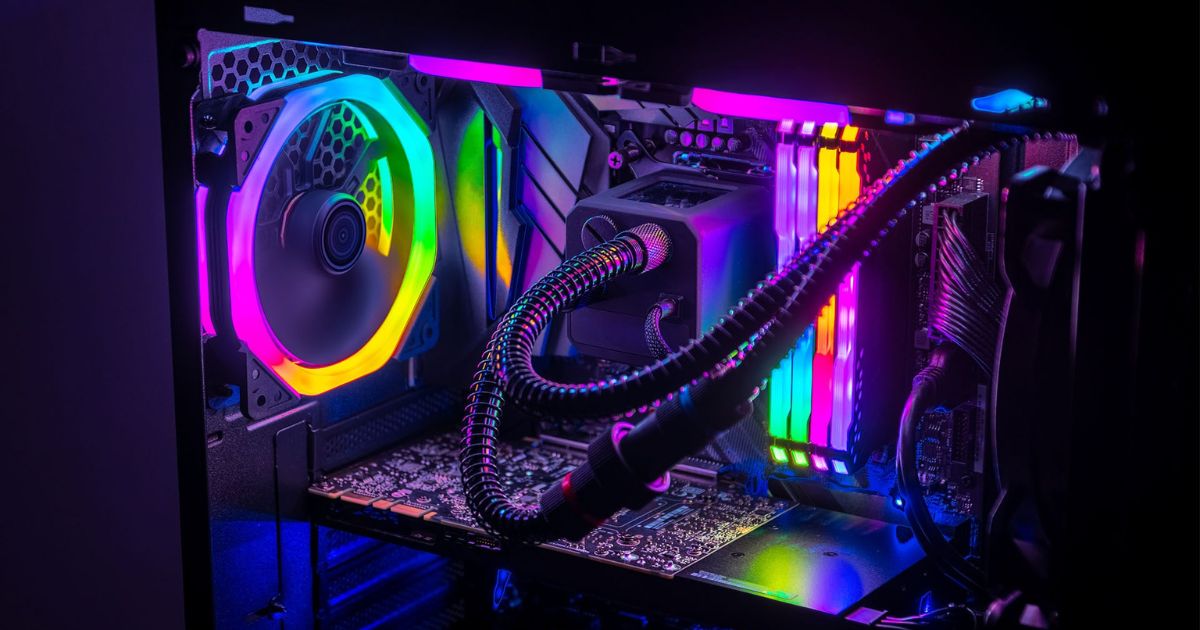Building your own gaming PC allows you to customize your system with high-quality components tailored to your needs and budget. In this guide, we’ll break down the steps to plan and assemble a custom gaming PC.
Choosing Gaming PC Parts
The key components that power any gaming rig include the CPU, graphics card (GPU), motherboard, memory (RAM), storage, power supply, and case. Carefully selecting each part is essential to build a system capable of smoothly running today’s demanding games.
CPU

The CPU, or central processing unit, acts as the “brain” of the PC. For gaming, I recommend an Intel Core i5 or AMD Ryzen 5 processor or higher. These mid-range CPUs offer excellent performance for both gaming and general use without breaking the bank.
GPU
The GPU, or graphics processing unit, handles all graphics-related processing and is critical for gaming. Nvidia and AMD are the two main manufacturers. For 1080p gaming, an Nvidia GTX 1060 or AMD RX 580 would be suitable, while 1440p or 4K demands a GTX 1070/1080 or RX Vega 56/64 or higher.
Motherboard

The motherboard is the central hub that connects all the other components. It must have the correct socket for your chosen CPU and sufficient PCIe slots for add-in cards like graphics cards. ATX is the standard size for most gaming PCs. Check that it supports the features and ports you need.
RAM
8GB of DDR4 RAM is adequate for most games today, though 16GB is recommended for future-proofing. RAM installed in matched pairs (like 2x4GB or 2x8GB) enables dual-channel mode for improved performance. Look for RAM rated at least 2666MHz for best compatibility.
Storage
A 120-256GB solid state drive (SSD) for the operating system and games is ideal for quick load times. Pair it with a 1-2TB mechanical hard disk drive (HDD) for bulk file storage. M.2 NVMe SSDs are also an option for bleeding-edge performance.
Power Supply
A quality 500-600W power supply unit (PSU) can sufficiently power most gaming builds. Look for 80+ Bronze efficiency or higher. Leave headroom for future upgrades too! Reputable brands include Corsair, EVGA, and SeaSonic.
Case

The case houses all the components. Mid-tower ATX cases have enough room without taking up too much space. Consider factors like build quality, ventilation, included fans and extras like RGB lighting or tempered glass when choosing.
Now that we’ve covered the core components, let’s move on to putting it all together!
Assembling the Gaming PC
Building a gaming PC may sound intimidating but involves mostly screwing components into their proper places with basic tools. Here are the step-by-step instructions:
Step 1: Prepare Your Workspace and Gather Tools
The following tools are needed:
- Phillips #1 and #2 screwdrivers
- Cable ties
- Antistatic wrist strap (optional but recommended)
- Screws and stands for motherboard, drives, etc.
Ensure a clear, well-lit space and have component boxes/manuals within easy reach.
Step 2: Install the CPU and CPU Cooler
Locate the CPU socket on the motherboard. Remove the retention arm and gently lower the CPU into place, ensuring the triangle alignment is correct. Then lock the retention arm over it. Screw on the included CPU cooler.
Step 3: Install the RAM
Open the memory slots on the motherboard and lined up the notches on the DIMM RAM module with the slot. Use firm pressure to fully insert. Clip both ends of the RAM into place.
Step 4: Install the M.2 SSD (if used)
The M.2 SSD installs directly onto the motherboard socket typically near the CPU. Secure it into place with the included screw.
Step 5: Install the Graphics Card
Locate the PCIe x16 slots and line up the card with them. Insert it fully until latched. Secure the PCIe end bracket to the case with screws. Plug any needed power inputs (6+2 pin).
Step 6: Install the I/O Shield
Before installing the motherboard into the case, insert the pre-installed I/O shield to cover the ports.
Step 7: Install the Motherboard
Carefully mount the motherboard tray standoffs if needed and sit the motherboard inside the case in its proper place. Use board screws to fasten the mounting holes along the edges and I/O plate.
Step 8: Install Storage Drives
Secure a 2.5″ SSD or HDD to the bottom of the case using screws through mounting points or clips. Install a 3.5″ HDD into drive bays using screws.
Click on this link to get more Knowledge “Latto Put it on Da Floor lyrics“
FAQs
Is it cheaper to build a gaming PC yourself?
In general, yes it is cheaper to build your own gaming PC rather than buy a pre-built system from retailers. When you build it yourself, you avoid the premium that manufacturers charge for assembly and support. You also get to individually select each component based on your budget and requirements to get the best value.
Is it hard to build a gaming PC?
Building a gaming PC is not as hard as it seems. As long as you take your time, carefully read manuals, and follow guide videos online, anyone can assemble one. The parts only go in one way. The tricky parts are things like installing the CPU, but as long as you apply thermal paste correctly and don’t bend any pins, it’s very straightforward.
What is needed to build gaming PC?
The main components needed are the CPU, motherboard, RAM, graphics card, solid state drive or hard drive, power supply, and computer case. You’ll also need basic tools like a screwdriver. Other optional extras include liquid cooling, extra case fans, lighting strips and so on.
How much does it usually cost to build a gaming PC?
A mid-range gaming PC that can play most AAA games at high settings 1080p can typically be built for $800-1200. Console-beating 1440p systems are doable from $1200-1600. For a top-end 4K-ready build, expect to spend $1600 and up depending on the components selected. You can also build capable starting systems for as low as $600 if you’more budget constrained.
Conclusion
And there you have it – all the steps required to successfully plan and assemble your own custom gaming PC! I hope this comprehensive guide has helped demystify the process and given you the knowledge to select high-quality parts and put them together with confidence.
Building your own system allows you to fine-tune specs exactly as desired while saving money over pre-builts. Don’t forget to install all necessary drivers and setup your preferred gaming library. From there it’s simply a matter of enjoying smooth framerates on all the latest titles with your new custom gaming rig!
As with any hobby or new project, don’t get discouraged if you encounter any minor issues along the way. Community forums like Reddit are great resources to troubleshoot problems. With some experience under your belt, upgrades and future rebuilds will become a breeze too.
I wish you the very best of luck on your gaming PC building journey. Feel free to reach out if you have any other questions. Now go and assemble that beast of a machine – you’ve got some gaming to do!




